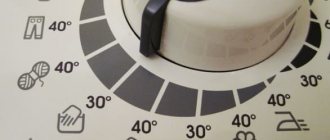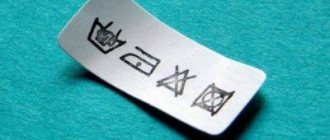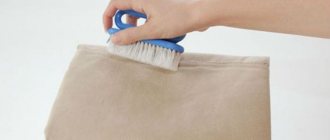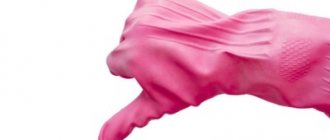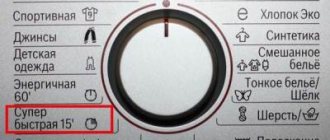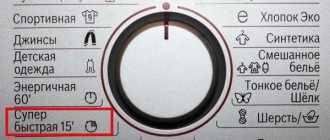Correctly selected washing mode is the key to long service life of clothes. Modern washing machines are equipped with a large number of programs to optimize this process.
One of the basic modes is delicate washing.
Read the article about what it is, what products it is suitable for and how to use it correctly.
What fabrics can be washed?
The delicate mode is intended for washing items made from fabrics that require careful handling. You can find out more information by studying the label. On it, in the form of signs, recommendations for washing various things are indicated.
Delicate wash is intended for items made from the following types of fabrics:
viscose;- polyester;
- elastane;
- lycra;
- silk;
- wool;
- organza;
- veil and more.
They resort to its help when things have a lot of additional attributes in the form of:
- rivets,
- lace,
- quilling,
- buttons,
- sequins,
- embroidery
In the delicate mode you can wash tulle and thin curtains, thermal underwear. It is suitable for caring for products prone to shedding, shrinkage, and stretching.
Whitening
Sometimes bleaches are used in the washing process. At this stage you need to be extremely careful. Some of them may leave a white spot or, in the worst case, a hole. So take a close look at your label.
and check if washing with bleach is allowed.
How to use bleach correctly?
| Bleaching is allowed. You can clean the product with chlorine and oxygen bleaches. |
| Bleaching is prohibited. Do not clean the product with chlorine or oxygen bleaches. |
| Chlorine bleaching is prohibited. You can only bleach with oxygen bleaches. |
| Chlorine bleaching is allowed. You can clean the product with chlorine-containing bleaches. |
Peculiarities
Delicate wash has the following features:
- The water temperature when selecting a program is 30 degrees.
- The spin speed does not exceed 400-600 rpm, depending on the SMA model.
- Drying is not provided in this mode.
- To indicate delicate washing, manufacturers use an image of a basin with water containing the number 30. Sometimes there are icons in the form of a feather, a flower, a butterfly, or a basin with a hand lowered into it.
- Program execution time varies. On average, a cycle takes about 60-80 minutes. The fact is that prolonged contact of thin fabrics with water is undesirable.
- Delicate washing is always accompanied by increased water consumption.
Wash
The manufacturer does not just indicate the recommended washing temperature. Many fabrics are afraid of high temperatures, for example, wool shrinks after cleaning in hot water, and silk wrinkles so that it is impossible to smooth it out later. Therefore, we advise you to pay attention to clothing tags more often.
How to choose the right temperature for washing?
In the table below we will tell you what the dots and numbers inside the basin icon mean and how to properly wash an item with such a tag.
.
| Hand wash only Forget about the washing machine, only gentle, delicate hand wash. |
| Machine wash in normal mode This symbol allows washing, soaking, heating, rinsing, rubbing and mechanical action. |
| Washing is prohibited. Do not do laundry at home. The product must be dry cleaned. |
| Wash in cool water Hand or machine wash at recommended temperature 30℃. |
| Wash in warm water Hand or machine wash at recommended temperature 40℃. |
| Wash in hot water Hand or machine wash at recommended temperature 50℃. |
| Wash in hot water Hand or machine wash at recommended temperature 60℃. |
| Wash in hot water Hand or machine wash at recommended temperature 70℃. |
| Wash in very hot water Hand or machine wash at recommended temperature 95℃. |
How to choose the right washing mode?
The number of lines under the basin symbol indicate which washing mode to choose: normal or delicate.
| Hand or delicate machine wash at 30℃ . Rub gently. You can rinse. Spin at low speed. |
| Hand or very delicate machine wash at 30 ℃ Minimum mechanical stress. Quick and gentle rinsing. Hand push-ups are prohibited. Use plenty of water. |
| Hand or very delicate machine wash at 30 ℃ Minimum mechanical stress. Quick and gentle rinsing. Hand push-ups are prohibited. Use plenty of water. |
| Hand or delicate machine wash at 40℃ . Rub gently. You can rinse. Spin at low speed. |
| Hand or very delicate machine wash at 40 ℃ Minimum mechanical stress. Quick and gentle rinsing. Hand push-ups are prohibited. Use plenty of water. |
| Hand or very delicate machine wash at 40 ℃ Minimum mechanical stress. Quick and gentle rinsing. Hand push-ups are prohibited. Use plenty of water. |
| Hand or delicate machine wash at 50℃ . Rub gently. You can rinse. Spin at low speed. |
| Hand or very delicate machine wash at 50 ℃ Minimum mechanical stress. Quick and gentle rinsing. Hand push-ups are prohibited. Use plenty of water. |
| Hand or very delicate machine wash at 50 ℃ Minimum mechanical stress. Quick and gentle rinsing. Hand push-ups are prohibited. Use plenty of water. |
| Hand or delicate machine wash at 60℃ . Rub gently. You can rinse. Spin at low speed. |
| Hand or very delicate machine wash at 60 ℃ Minimum mechanical stress. Quick and gentle rinsing. Hand push-ups are prohibited. Use plenty of water. |
| Hand or very delicate machine wash at 60 ℃ Minimum mechanical stress. Quick and gentle rinsing. Hand push-ups are prohibited. Use plenty of water. |
| Hand or delicate machine wash at 70℃ . Rub gently. You can rinse. Spin at low speed. |
| Hand or very delicate machine wash at 70 ℃ Minimum mechanical stress. Quick and gentle rinsing. Hand push-ups are prohibited. Use plenty of water. |
| Hand or very delicate machine wash at 70 ℃ Minimum mechanical stress. Quick and gentle rinsing. Hand push-ups are prohibited. Use plenty of water. |
| Hand or delicate machine wash at 95℃ Rub gently. You can rinse. Spin at low speed. |
| Hand or very delicate machine wash at 95 ℃ Minimum mechanical stress. Quick and gentle rinsing. Hand push-ups are prohibited. Use plenty of water. |
| Hand or very delicate machine wash at 95 ℃ Minimum mechanical stress. Quick and gentle rinsing. Hand push-ups are prohibited. Use plenty of water. |
Terms of use
For washing to live up to its name, the following rules must be followed:
do not set the water temperature above 30 degrees;- the maximum permissible spin speed should be 600 rpm, if possible, it should be abandoned altogether;
- It is better to disable additional or double rinsing;
- colored items should be washed separately from whites and blacks;
- the drum should be loaded halfway - the more things are put in it, the lower the quality of washing; the maximum permissible weight of dry laundry is 1.5 kg;
- if the water is hard, it is recommended to use a conditioner;
- delicate washing does not require pre-soaking, so the tray numbered I or marked with the letter A is left empty.
How long does it take to rinse in a washing machine?
The time it takes to rinse depends on the options selected. How many rinses are needed is decided either by the machine itself (the manufacturer) or by the user. The laundry needs to be rinsed thoroughly, and you cannot skimp on this. If the user considers it necessary, he sets an additional rinse, which will increase the cycle by 20–30 minutes.
On almost all brands of SMA, rinsing is indicated by the same icon - a basin with a wavy line or straight lines. Rinsing is one of the main steps. On many machines, the “rinse” button is even located separately. When rinsing, the water is automatically drained. The duration depends on the brand and model of SMA. One rinse may take 10–30 minutes.
Detergents
Delicate fabrics require the use of liquid detergents. Gels are best suited for this purpose. If the product is heavily contaminated, you can use capsules that are placed directly into the SMA drum. They contain a higher concentration of surfactants, which makes it possible to get rid of difficult stains faster.
The advantage of using gels is that they do not contain chlorine, phosphates and enzymes, if we are talking about quality products. This will avoid color fading and damage to delicate fabrics.
Classic washing powders can be used if there is no alternative. However, it must be taken into account that they are less easily washed out of the fabric fibers, which requires turning on the additional rinsing function. The longer an item is exposed to mechanical stress, the higher the likelihood that pills will appear on it.
If possible, it is better to use products that match the type of fabric. There are gels on sale for:
- black and white things,
- for wool,
- cashmere,
- silk, etc.
How to install it yourself?
If you don’t find any of the programs described above in the functionality of your SMA, it doesn’t matter - you can set the necessary settings yourself. How to make washing gentle? Configure the settings correctly:
- Water heating is 30–40 °C.
- Add an extra rinse.
- Turn off spin. If your product allows it, set the drum speed to 60 rpm.
So you have ideal conditions for capricious fabrics - wash without fear.
Preparing laundry
Preparing items for delicate washing involves performing the following steps:
Things are sorted by color. Black, colored and white items should be washed separately.- If things are heavily soiled, they are pre-soaked in a basin of warm water.
As a safe product, you can use a liquid stain remover, which is applied to the stain point by point, according to the instructions. A popular folk remedy is soda solution. - To safely wash openwork linen or napkins, they can be attached with a few stitches to dense fabric of a similar color and placed in this form in the drum.
- Silk and cashmere are washed separately.
- Things must be turned inside out.
- Buttons and zippers are closed, pockets are turned inside out to make sure there are no foreign objects in them.
- You should purchase liquid detergent in advance.
If you are washing a product for the first time, it is better to first conduct a small test for pigment stability.
To do this, dissolve the gel in water in the concentration in which it will be used in the washing machine and apply it to an inconspicuous area of fabric for 10-15 minutes. Then any white material is applied to it. If there are no streaks left on it, you can safely start washing.
Drying and ironing after
Features of drying clothes after delicate washing:
- if the manufacturer allows automatic spinning, then it should be performed at the lowest possible speed;
- if machine spinning is prohibited, after washing the items are removed from the drum, wrapped in a terry towel and allowed to absorb excess moisture - most delicate fabrics do not tolerate twisting well;
- after completion of the cycle, the laundry must be removed from the drum immediately;
- You should not hang the products; it is best to leave them to dry on a flat surface, manually straightening out creases and folds.
The product should be ironed slightly damp, turning it inside out. The iron is moved carefully, without applying force or putting pressure on it. For greater safety, cover the fabric with a layer of gauze. If possible, use a steamer.
Icon on washing machines of different brands
Depending on the brand of washing machine, the program will have some differences:
Bosch . The mode may be called “Delicate wash”, “Delicates”, “Silk”. The spin speed is 400 rpm, the water temperature is 30 degrees, the washing duration is half an hour.- . Default settings: water heating – 30 degrees, spin speed – 400 rpm. With these parameters, the wash lasts 48 minutes. If you turn off water heating and spin, the cycle time will be reduced to 27 minutes.
- Indesit . The water heats up to 30 degrees, the spin does not exceed 400 rpm. The cycle lasts 80 minutes. The maximum drum load is 1.5 kg.
- Samsung . The water temperature can reach 40 degrees, and the spin speed is 600 rpm. The cycle lasts 1 hour.
- Candy . The manufacturer classifies the following modes as delicate programs: “Delicate”, “Wool”, “Hand Wash”. The water temperature is 30-40 degrees. The cycle lasts from 40 to 59 minutes.
How to turn it on?
It happens that the control panel does not have the necessary inscription - how can you install a gentle program in this case? Look for similar names - check the instructions, you need options that match the type of matter or temperature up to 40 degrees. Select the desired option using the selector switch or button - as provided in your machine, and press "start".
The program for delicate fabrics may have different names, but its essence is the same - a gentle approach to washing. The name may differ for different brands and models, but this does not prevent the user from finding the desired option. Any gentle regime is different:
- slow rotation of the drum;
- low water temperature.
Advantages and disadvantages of the program
Pros of using the program:
- careful attitude to things;
- color protection and extension of product life;
- short cycle time, which saves electricity.
Minuses:
- increased water consumption - however, this should not become an obstacle to using the program, since items made from delicate fabrics cost more than a few liters of water;
- difficulties in removing stubborn stains - to achieve results, sometimes you have to soak things in advance and use stain removers;
- the need to use liquid detergents.
Professional dry cleaning
These symbols are intended for dry cleaning professionals. They will tell them how to properly clean your product, which compounds are allowed to be used to clean your clothes, and which are strictly prohibited.
Dry cleaning clothes
| Dry clean only Do not use large volumes of water. |
| It is prohibited to treat with chemicals. You cannot use chemicals to wash the product. |
| Dry cleaning with tetrachlorethylene, etc. Cleaning the product without water using tetrachlorethylene (PCE), hydrocarbons, ethylene chloride, monofluorotrichloromethane. |
| Delicate dry cleaning with tetrachlorethylene, etc. Cleaning with a small amount of water using tetrachlorethylene (PCE), hydrocarbons, ethylene chloride, monofluorotrichloromethane. |
| Dry cleaning with hydrocarbons, etc. Cleaning the product using hydrocarbons, monofluorotrichloromethane. |
| Delicate dry cleaning with hydrocarbons, etc. Gentle cleaning of the product using hydrocarbons, monofluorotrichloromethane. |
| Reduced dry cleaning A shortened cleaning cycle for the product is allowed. |
| Low temperature dry cleaning Clean the product in cool water. |
| Dry cleaning without steaming The use of steam at the final stage of dry cleaning is prohibited. |
| Dry cleaning in low humidity It is allowed to clean the product in low humidity. |



